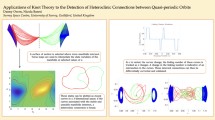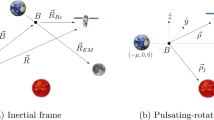Abstract
The motion of a point mass in the J 2 problem is generalized to that of a rigid body in a J 2 gravity field. The linear and nonlinear stability of the classical type of relative equilibria of the rigid body, which have been obtained in our previous paper, are studied in the framework of geometric mechanics with the second-order gravitational potential. Non-canonical Hamiltonian structure of the problem, i.e., Poisson tensor, Casimir functions and equations of motion, are obtained through a Poisson reduction process by means of the symmetry of the problem. The linear system matrix at the relative equilibria is given through the multiplication of the Poisson tensor and Hessian matrix of the variational Lagrangian. Based on the characteristic equation of the linear system matrix, the conditions of linear stability of the relative equilibria are obtained. The conditions of nonlinear stability of the relative equilibria are derived with the energy-Casimir method through the projected Hessian matrix of the variational Lagrangian. With the stability conditions obtained, both the linear and nonlinear stability of the relative equilibria are investigated in details in a wide range of the parameters of the gravity field and the rigid body. We find that both the zonal harmonic J 2 and the characteristic dimension of the rigid body have significant effects on the linear and nonlinear stability. Similar to the classical attitude stability in a central gravity field, the linear stability region is also consisted of two regions that are analogues of the Lagrange region and the DeBra-Delp region respectively. The nonlinear stability region is the subset of the linear stability region in the first quadrant that is the analogue of the Lagrange region. Our results are very useful for the studies on the motion of natural satellites in our solar system.
































Similar content being viewed by others
References
Aboelnaga, M.Z., Barkin, Y.V.: Stationary motion of a rigid body in the attraction field of a sphere. Astronom. Zh. 56(3), 881–886 (1979)
Balsas, M.C., Jiménez, E.S., Vera, J.A.: The motion of a gyrostat in a central gravitational field: phase portraits of an integrable case. J. Nonlinear Math. Phys. 15(s3), 53–64 (2008)
Barkin, Y.V.: Poincaré periodic solutions of the third kind in the problem of the translational-rotational motion of a rigid body in the gravitational field of a sphere. Astronom. Zh. 56, 632–640 (1979)
Beck, J.A., Hall, C.D.: Relative equilibria of a rigid satellite in a circular Keplerian orbit. J. Astronaut. Sci. 40(3), 215–247 (1998)
Beletskii, V.V., Ponomareva, O.N.: A parametric analysis of relative equilibrium stability in a gravitational field. Kosm. Issled. 28(5), 664–675 (1990)
Bellerose, J., Scheeres, D.J.: Energy and stability in the full two body problem. Celest. Mech. Dyn. Astron. 100, 63–91 (2008)
Boué, G., Laskar, J.: Spin axis evolution of two interacting bodies. Icarus 201, 750–767 (2009)
Breiter, S., Melendo, B., Bartczak, P., Wytrzyszczak, I.: Synchronous motion in the Kinoshita problem. Applications to satellites and binary asteroids. Astron. Astrophys. 437(2), 753–764 (2005)
Broucke, R.A.: Numerical integration of periodic orbits in the main problem of artificial satellite theory. Celest. Mech. Dyn. Astron. 58, 99–123 (1994)
Hall, C.D.: Attitude dynamics of orbiting gyrostats. In: Prętka-Ziomek, H., Wnuk, E., Seidelmann, P.K., Richardson, D. (eds.) Dynamics of Natural and Artificial Celestial Bodies, pp. 177–186. Kluwer Academic, Dordrecht (2001)
Hughes, P.C.: Spacecraft Attitude Dynamics, pp. 281–298. Wiley, New York (1986)
Kinoshita, H.: Stationary motions of an axisymmetric body around a spherical body and their stability. Publ. Astron. Soc. Jpn. 22, 383–403 (1970)
Koon, W.-S., Marsden, J.E., Ross, S.D., Lo, M., Scheeres, D.J.: Geometric mechanics and the dynamics of asteroid pairs. Ann. N.Y. Acad. Sci. 1017, 11–38 (2004)
Maciejewski, A.J.: Reduction, relative equilibria and potential in the two rigid bodies problem. Celest. Mech. Dyn. Astron. 63, 1–28 (1995)
Marsden, J.E., Ratiu, T.S.: Introduction to Mechanics and Symmetry. TAM Series, vol. 17. Springer, New York (1999)
McMahon, J.W., Scheeres, D.J.: Dynamic limits on planar libration-orbit coupling around an oblate primary. Celest. Mech. Dyn. Astron. 115, 365–396 (2013)
Scheeres, D.J.: Stability in the full two-body problem. Celest. Mech. Dyn. Astron. 83, 155–169 (2002)
Scheeres, D.J.: Stability of relative equilibria in the full two-body problem. Ann. N.Y. Acad. Sci. 1017, 81–94 (2004)
Scheeres, D.J.: Spacecraft at small NEO (2006). arXiv:physics/0608158v1
Scheeres, D.J.: Stability of the planar full 2-body problem. Celest. Mech. Dyn. Astron. 104, 103–128 (2009)
Teixidó Román, M.: Hamiltonian methods in stability and bifurcations problems for artificial satellite dynamics. Master thesis, Facultat de Matemàtiques i Estadística, Universitat Politècnica de Catalunya, pp. 51–72 (2010)
Vereshchagin, M., Maciejewski, A.J., Goździewski, K.: Relative equilibria in the unrestricted problem of a sphere and symmetric rigid body. Mon. Not. R. Astron. Soc. 403, 848–858 (2010)
Wang, Y., Xu, S.: Gravitational orbit-rotation coupling of a rigid satellite around a spheroid planet. J. Aerosp. Eng. (in press). doi:10.1061/(ASCE)AS.1943-5525.0000222
Wang, Y., Xu, S.: Hamiltonian structures of dynamics of a gyrostat in a gravitational field. Nonlinear Dyn. 70(1), 231–247 (2012)
Wang, Y., Xu, S.: Symmetry, reduction and relative equilibria of a rigid body in the J 2 problem. Adv. Space Res. 51(7), 1096–1109 (2013a)
Wang, Y., Xu, S.: Gravity gradient torque of spacecraft orbiting asteroids. Aircr. Eng. Aerospace Technol. 85(1), 72–81 (2013b)
Wang, L.-S., Krishnaprasad, P.S., Maddocks, J.H.: Hamiltonian dynamics of a rigid body in a central gravitational field. Celest. Mech. Dyn. Astron. 50, 349–386 (1991)
Wang, L.-S., Maddocks, J.H., Krishnaprasad, P.S.: Steady rigid-body motions in a central gravitational field. J. Astronaut. Sci. 40(4), 449–478 (1992)
Wang, L.-S., Lian, K.-Y., Chen, P.-T.: Steady motions of gyrostat satellites and their stability. IEEE Trans. Autom. Control 40(10), 1732–1743 (1995)
Wisdom, J.: Rotational dynamics of irregularly shaped natural satellites. Astron. J. 94, 1350–1360 (1987)
Acknowledgements
This work is supported by the Innovation Foundation of BUAA for PhD Graduates, the Graduate Innovation Practice Foundation of BUAA under Grant YCSJ-01-201306 and the National Natural Science Foundation of China under Grant 11172020.
Author information
Authors and Affiliations
Corresponding author
Appendix: Formulations of coefficients in characteristic equations
Appendix: Formulations of coefficients in characteristic equations
The explicit formulations of the coefficients in the characteristic equations Eqs. (38) and (50) are given as follows:












Rights and permissions
About this article
Cite this article
Wang, Y., Xu, S. Stability of the classical type of relative equilibria of a rigid body in the J 2 problem. Astrophys Space Sci 346, 443–461 (2013). https://doi.org/10.1007/s10509-013-1473-7
Received:
Accepted:
Published:
Issue Date:
DOI: https://doi.org/10.1007/s10509-013-1473-7




